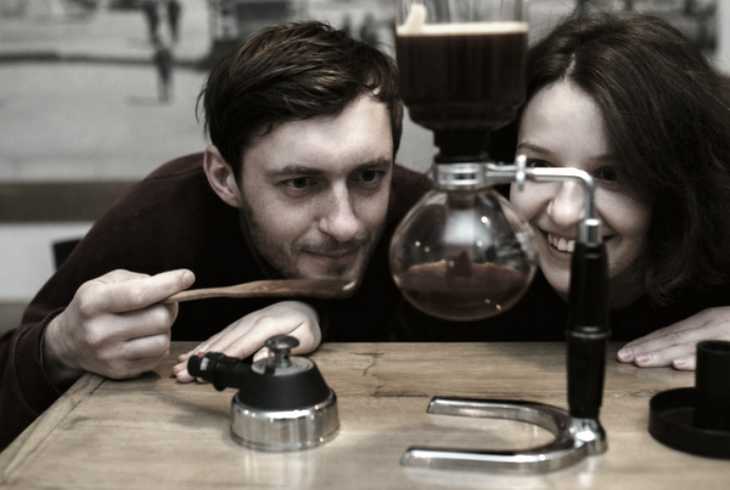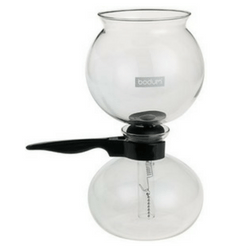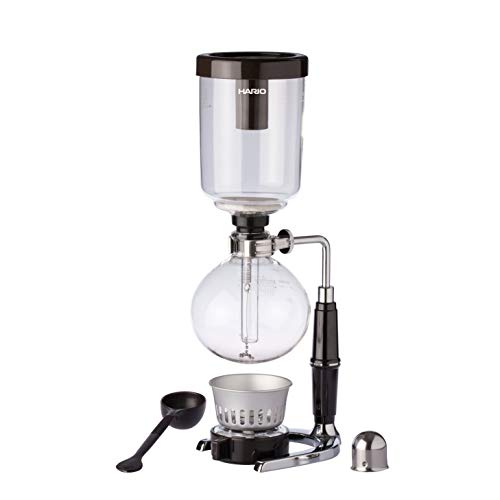Although siphon coffee makers have gained outstanding popularity only in recent years, they have been in existence for as long as coffee brewing itself.
The technique dates back in the 1750's when people started studying the effect pressure would have on their beverages. Moreover, the first commercial siphon coffee maker entered the market later in the mid-1800's from the French territories.
What sparked this interest, you ask?

Well, people started noticing that boiling, the main coffee preparation method at the time, damaged coffee in terms quality. The vacuum method is quite distinct and superior from the rest.
First and foremost, the end product is very clean. Secondly, full immersion ensures that the rich coffee flavor is retained. For best results, use dry, processed beans.
If you're new to the world of vacuum brewing, finding the siphon vacuum pot that is right for you can be overwhelming. That is why we have created a list of the 5 best siphon coffee makers with a buyer's guide and tutorial on how to use a siphon coffee maker.
Quick Siphon Comparison
Rank | Image | Make & Model | Rating | |
|---|---|---|---|---|
1 | Hario / Technica | |||
2 | Yama Glass / Stovetop | |||
3 | Bodum / 1208-01US4 | |||
4 | Nispira / 4335900143 | |||
5 | Yama Glass / YAMTCA5D |
Best Siphon Coffee Maker Reviews
1
Hario Technica 5 Cup Coffee Syphon
Highlighted Features
The Hario brand is renowned for their quality and sense of style in all their gadgets, in particular, their coffee makers. As the name suggests, the Hario coffee siphon can make up to five cups. Furthermore, the exterior is made of the highly resilient borosilicate glass, signature glassware from Hario.
This model ships with a cloth filter and an alcohol burner. Note, the alcohol burner might be a little slow considering the fact that you are brewing 5 cups. However, you can speed things up a little by preheating the water.
Also, replacing the alcohol burner with a butane burner is a good option. When doing replacements for the burner, make sure that it does not touch the glass or else it might break it.
See the Hario Siphon Brewer Demo [Video]
What We Liked [Pros]
What We Didn't Like [Cons]
Some folks find the cloth filter to be inconvenient. You might want to consider using paper filters. However, you will have to get a metal filter holder. Why you ask? Well, its because the filter holder that comes with this particular Hario only works with cloth filters. Siphon coffee makers push water upwards. You cannot avoid buying a metal filter holder or else the paper filters will float.
You probably have seen it in coffee shops or cafes and in YouTube videos. It is a perfect example of the absolute functionality of a siphon coffee maker. The structure is quite firm and perfectly sealed (no leakages). Also, the drainage is reliable. Overall, this brewer is a good investment.
2
Yama Glass 8 Cup Stovetop Siphon
Highlighted Features
The Yama 8-cup is a stovetop model from Japan. It is a highly aesthetic creation with round glass parts. And the handle is made from a heat insulating material.
Also. the Yama glass coffee siphon has a capacity of 40 ounces (8 cups). Moreover, it's also available in a 5-cup (20oz) capacity. This model is made of the highly heat-resistant borosilicate glass. The firmness of the structure makes it ideal for dishwasher and microwave use.
If you were to measure the capacity using a typical coffee mug, the Yama 8-cup would produce at least 4 of them. If you do everything right, brewing the full amount (8 little cups) should take you exactly 20 minutes. This is a little longer than when using an electric coffee maker, but it’s worth the wait.
The process produces a rich, quality taste and flavor. Although, the exact flavor depends on the quality of coffee you use.
See the Siphon Coffee Pot Demo [Video]
What We Liked [Pros]
What We Didn't Like [Cons]
Note: The coffee brews on the glass surface downright. There should be no plastic/metal odors and taste whatsoever. So, making a smaller amount like two cups is not advisable - the coffee will be much more delicious if you brew the full amount.
Some customers claim that theirs exploded because the structure could not withstand the pressure while using a glass rod filter. This rarely happens when using metal mesh and cloth filters.
Considering the high number of satisfied users, this is definitely a piece you should try. Also, the cheap price plus the aesthetics is something to consider. The good packaging makes it ideal for sending to someone special as a surprise gift.
3
Bodum Pebo Vacuum Coffee Maker
Highlighted Features
Admittedly, all siphon coffee brewers make a great cup of coffee. However, this Scandinavian design model does one thing in a special way, which is, confining the aroma ensuring that none escapes. Note, this vacuum coffee maker is made in china.
The Bodum Pebo (formerly Santos) is a very elegant and durable piece. On full capacity, it should serve 8 small coffee cups or 4 typical coffee mugs. Also, the lower carafe is designed for serving meaning that you do not need to empty the coffee on a separate serving pot.
The Santos is renowned for its ability to balance aesthetics and functionality. It is slightly larger than the Yama 8-Cup Stovetop Siphon above. It's easy to clean, not to mention that it is also dishwasher friendly just like the Yama.
Having Fun Making Coffee In Bodum Pebo [Video]
What We Liked [Pros]
What We Didn't Like [Cons]
Note: Unlike most vacuum siphon coffee makers, the Bodum Pebo 8-cup does not come with a lid/ cover for the top chamber. Functionally, this should not be a problem unless you use too much water.
The Bodum Pebo is a good investment for anyone who likes enjoying a perfectly made cup of coffee. It is the perfect piece, especially for home use. However, this might not be the piece for you if you are the kind of person who cannot wait for a while to enjoy a cup of coffee.
4
Nispira Luxury Balance Syphon
Highlighted Features
The gold color of the royal balancing siphon coffee maker and the dark-red color of the wooden base make it a top choice for many. A single brew makes 3 to 5 Espresso cups (2 normal coffee cups). Also, the water retainer and plug are made of stainless steel.
In typical vac pots, one chamber is on top of the other with a filter in between. This is not so when it comes to the Nispira. It uses the balance siphon method where the chambers are stationed next to each other.
The fact that it is made in China does not necessarily mean that this is a rip-off. In fact, most people find it more convenient and classy than other overpriced models- it makes the smoothest coffee ever. Although, most customers find the overall packaging and instructions to be more Chinese-oriented, everything has being subtitled in understandable English.
Royal Balancing Syphon Coffee Maker Demo [Video]
What We Liked [Pros]
What We Didn't Like [Cons]
Note: It is very delicate and might break during shipment. Extreme care is required for daily use.
Fundamentally, the Nispira is an early siphon coffee maker made in a modern way. Definitely, it is a good investment for any person who admires detailed gadgetry plus good aesthetics.
5
Yama Tabletop Siphon Coffee Maker
Highlighted Features
The Yama glass coffee siphon is a favorite for many. It is firm and even better, suitable for brewing small amounts. Favorably, it is made of the highly resilient borosilicate glass.
Moreover, it also does not go low with the aesthetics. It features a table top design. And has vintage-looking brewing chambers mounted on a stylish, convertible stand.
The Yama Glass 5 cup Tabletop siphon is among the best siphon coffee makers recommended by the Coffee Geek. According to them, this is the secret for making a smooth and delicious cup of coffee. It comes with a soot free, denatured alcohol burner.
What We Liked [Pros]
What We Didn't Like [Cons]
This coffee siphon maker is probably the best choice especially if you only want to try out siphon brewed coffee.
Siphon Coffee Maker Buyer's Guide

What is a siphon coffee maker?
A siphon coffee maker is a simple machine that uses a full immersion system to brew coffee. It uses a continuous heat source all the while.
The constant heat helps create an air-free atmosphere (vacuum) on one chamber by driving away water and air into an adjacent chamber where the water mixes with the ground coffee. The coffee-water mixture is then sieved on the way back to the vacuum chamber.
As you will come to notice, siphon coffee makers are easy to use. They are also quite fascinating to watch. This makes the whole process enjoyable.

Where did the siphon come from?
Every gadget invention story starts with the mention of a great scientist or nerd who never left his laboratory for years. However, this is not so when it comes to siphon coffee makers. The vacuum brewing technology is a contribution of many.
The first commercial Siphon coffee maker developed by Marie Fanny of France was an adoption of an earlier version of the first (probably) by Leoff, a Berliner.
Moreover, the two were almost similar pieces, each featuring two typical glass balloons held by a frame at the center. The first version to be recognized through an award was the Napier Coffee Pot, a creation by a Scottish mariner.
Why would you use a siphon?
This type of coffee brewing machine is probably the most widely used especially in shops. Aesthetically speaking, a siphon coffee maker is a special piece.
What’s better is that the beauty matches the functionality with zero chances for failure. It the best piece for showing off your coffee brewing mastery in front of your guests.
Let us now have a detailed look at some other factors that set them apart from other coffee brewing procedures:
The Vacuum
Siphon coffee makers derive their name from this feature. The vacuum acts as suction for the ground coffee after it has completely immersed in water. Note, the pressure not only aids the mixture to go through the filter but it also enriches the coffee with a unique taste and fragrance.
Full Immersion
This means that the processed coffee is in immersed totally in water throughout the entire brewing process. Which counts as an advantage, because the solvent extracts every bit of the coffee’s nourishment to the last minute.
Balanced Heat All Along
The quality of heating determines the taste, flavor, and overall quality of the end product. Also, the heat adds to the rumble necessary for coffee brewing. Continuous, moderate heating is usually the best.
With Syphon coffee makers, adding pre-heated water is not necessary. The machine’s body is heated by a constant heat source throughout the brewing process. Some Siphon coffee makers even allow you to control the heat’s intensity.

How do siphons work?
It's all science! Siphon coffee makers have two chambers. This distinctive characteristic makes all the science possible.
The lower one is filled up with water. Next, the heat evaporates the water forcing it into the upper chamber as water vapor where it mixes with the coffee.
After removing the heat source, the lower carafe cools down. Which creates a partial vacuum in the lower flask which causes a drop in pressure.
This, together with gravity force, creates suction in the lower chamber which pulls the mixture into the lower flask through the filter.
Siphon coffee brewers are made in such a way that the lower carafe will be void of water at some point. Leaving some water in the lower chamber, as most people advice, so as to avoid cracking would dilute your coffee.
Note: Quality glass should be capable of withstanding fluctuations in temperature and pressure without shattering.
Types of Filters
All siphon coffee makers come with a filter. Most of them come with a cloth filter. If you are dissatisfied with it, you should consider replacing it with a different filter.
Here are other types of filters:
Glass Filters: Usually, this type of filter will have a bulbous middle or a rough surface that traps the coffee grounds. However, they are not as effective as cloth filters because they allow a substantial amount of solids to pass through. Still, some people find this useful.
Paper Filters; These provide a similar product to that of the drip brew system. Paper filters are disposed of after use. Most people find this to be more efficient than always cleaning a filter after brewing.
Metal with Mesh Filters: These filters also let sediment to pass through. They are circular with a rubber tubing enclosing the outer edge.
Metal [Non-Mesh] Filters: People love this filter so much. It is quite functional and easy to clean. Although, it lets a substantial amount of sediment to pass through. It has two sizable disks with holes that offset to each other. A rod holds the disk in place. And a chain and spring device secures it to the bottom of the siphon flask.
Nylon Mesh Filters: Nylon filters let more of the coffee goodies to pass through than paper filters. However, they are fragile pieces that get torn very easily, but they are best if you are a dishwasher person.
What are the heating options for siphons?
There are two main options when it comes to heating. You can go with a stove-top design or a standalone design. Stove top models, as the name suggests, have to sit on a flame (electric or gas) while standalone models have inbuilt or separate alcohol or gas burners.
You can tell the mode of heating the coffee maker uses by just looking at the base. Round bases indicate that the station must sit on a flame. Stovetop designs usually have flat bases.
What to look for when buying a siphon?
How to Make Coffee in a Siphon
What You'll Need
01 Prep the Filter
You have to assemble your filter before anything else. Cloth filters and metal filters are the most commonly used. For this process, we are going to use a metal filter.
02 Add the Water
Add the desired amount of water into the lower carafe. Use pre-heated water to speed things up. Wipe off any water droplets on the flask to prevent the glass from cracking. In this case, we are using the 5-cup capacity- fill water up to the 5 cup mark.
03 Apply Heat
Bring your heat source to life. Turn the heat on high. Insert the already assembled upper part into the lower carafe and leave it to warm up. You just want it to warm up- securing it is not necessary at this level.
04 Grind Your Beans
Use a scale to measure the desired amount of coffee. For a 5-cup, 6 tablespoons (40g) should be enough. You should then grind the coffee beans- a medium coarse grind is usually the best.
05 Attach the Funnel
Secure the upper part. Water vapor should start filling the top part immediately. It is always advisable to leave some water in the lower chamber.
06 Add the Coffee
Stir the water to get a swirl-effect and then add in the ground coffee. The swirl helps the ground coffee to get saturated. Continue stirring until everything is saturated up.
07 Lower the Heat
Turn the heat source to low. Wait for 10 seconds and stir again. This time you should do it gently.
08 The Draw
Wait for 1.5 minutes and remove the heat source. The coffee should move down to the lower carafe through the filter. This should take about 3 minutes.
09 Serve & Enjoy
Remove the top part. Enjoy your coffee!
Final Thoughts
Siphon coffee brewing is very enjoyable. It is the furthest you can go with sophistication when it comes to making a darn good cup of coffee. Most people claim it would take a staunch coffee person to make a cup using this method every day. However, this is not true. Most people are already used to every day siphon coffee brewing.
The procedure(s) in this guide should not be followed to the letter. They should only be used to help you get an overview of what is expected. Choosing the amount of coffee to use (this is one huge concern for most people) and the timing intervals really depends on the individual.
Did you enjoy reading this best siphon coffee makers guide? Please let us know your thoughts. Don't forget to share the article with your friends!
Happy Siphoning!















